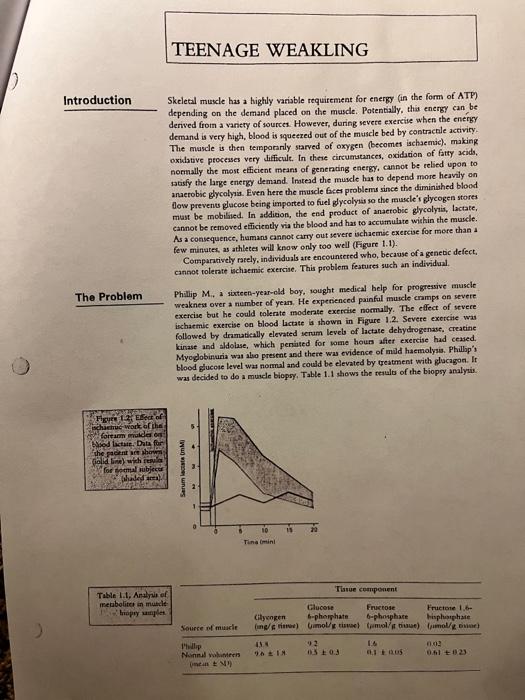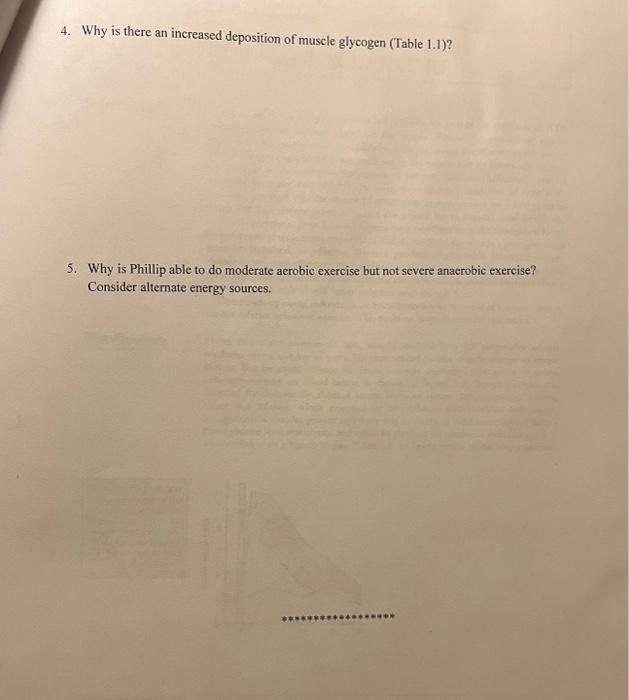TEENAGE WEAKLING Introduction Skeletal muscle has a highly variable requirement for energy (in the form of ATP) depending on the demand placed on the muscle. Potentially, this energy can be derived from a variety of sources. However, during severe exercise when the energy demand is very high blood is squeered out of the muscle bed by contractile activity The muscle is then temporanly starved of oxygen (becomes ischaemac). making oxidative processes very difficult. In these circumstances, oxidation of fatty acids, normally the most efficient means of generating energy cannot be relied upon to satisfy the large energy demand. Instead the muscle has to depend more heavily on anaerobic glycolysis. Even here the muscle faces problems since the diminished blood dow prevenu glucose being imported to fuel ycolysis so the muscle's plycogen stores must be mobilised. In addition, the end product of anaerobic glycolysis, lactate, cannot be removed efficiently via the blood and has to accumulate within the muscle. As a consequence, humans cannot carry out severe ischaemic exercise for more than a few minutes, as athletes will know only too well (Figure 1.1). Comparatively rarely, individuals are encountered who, because of a genetic defect. cannot tolerate ischaemic exercise. This problem features such an individual The Problem Phillip M, a sixteen-year-old boy. sought medical help for progressive muscle weakness over a number of yean. He experienced painful muscle cramps on severe exercise but he could tolerate moderate exercise normally. The effect of severe ischaemic exercise on blood lactate is shown in Figure 1.2. Severe exercise was followed by dramatically elevated serum level of lactate dehydrogenase, creatine kinase and aldolase, which persisted for some houn after exercise had ceased. Myoglobinuria was abo present and there was evidence of md haemolysis. Phillops blood glucose level was normal and could be elevated by treatment with glucagon. It was decided to do a muscle biopsy. Table 1.1 shows the results of the biopsy analysis. Hur 12. Eet of Schache work of the foram mulden sodacte. Data for the date show alle wichele formal subject Wha) Sarum lectus NMD 10 Tina Tianue component Table 1.1, Analysis of meabolite in muide biopsy wet Clucere Fructose Fructose 1.- Cilyngen -phaphate 6-phosphate hisphosphate ling/m) molde ise tamollatie) mol/g Source of much I'lp Nonnal viens EN) 93 03 E03 ES X2 0.1023 Use the Homework #2 Glycolysis pathway you have drawn to help you answer the questions below. Draw out the biochemical pathway for conversion of glucose to lactate. Include structures of all metabolites (Lewis structures in Fisher projection form). Indicate all cofactors (by name, no need for structures). Include specific names of all enzymes, and indicate type of chemical reaction that occurs at cach step (phosphorylation, isomerization, oxidation, etc.). 1. Why is lactate, rather than pyruvate, produced by normal muscle when it is working anaerobically? 2. What do the results of the ischaemic exercise (Fig 1.2) suggest is wrong with Phillip's muscles? Explain. 3. What can you conclude from the muscle biopsy analysis (Table 1.1)? From your deductions so far, what do you think is the metabolic defect in the patient? Explain your reasoning. 4. Why is there an increased deposition of muscle glycogen (Table 1.1)? 5. Why is Phillip able to do moderate aerobic exercise but not severe anaerobic exercise? Consider alternate energy sources









